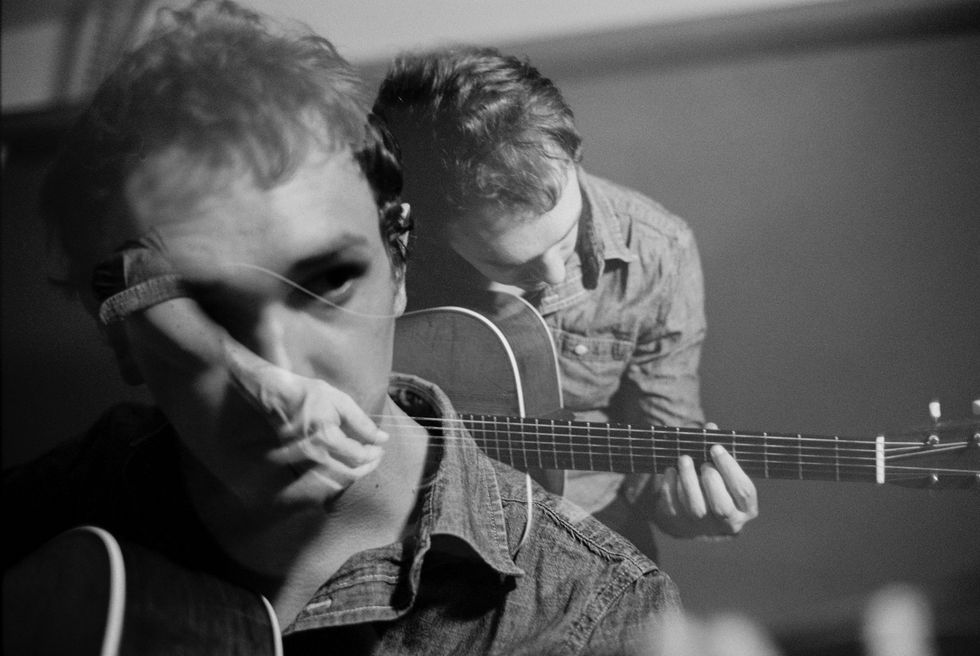Ben Garnett’s debut album opens bravely, almost daring the casual listener to give up before anything recognizable as a tune emerges from the speakers. Instead, we hear a collage of abstract sound—a tape spooling backwards, spectral voices, and stringed instruments being rubbed and scraped. Out of these two minutes of gentle cacophony, an angular theme emerges, tentative at first, played on banjo and fiddle. Then the idea organizes itself into the punchy, gypsy-derived melody of “Thirty One Mouths.” And with that, the remarkable Imitation Fields gets underway.
Garnett manages to not imitate anyone on record or in his burgeoning performing career in the progressive acoustic arena. With electronic overlays, judicious use of noise, and passages of richly composed chamber music, he pushes the avant-garde boundaries of the string-band sound. And within this album lies the story of a guitar player who’s evolved from instrumental rock, through formal jazz studies, to cutting-edge acoustic music—all with intuition and skill.
Garnett established himself as a Nashville pro playing guitar in the band of bluegrass-star bassist Missy Raines. He also joined the newgrass quartet Circus No. 9 and launched a jazz trio that interprets a repertoire linking Miles Davis to Bill Monroe. So, at 28, with a unique set of influences and a head full of ideas, the time was right for Garnett to make a personal artistic statement. It wasn’t an easy or quick journey, but the result is both enthralling and challenging.
Ben Garnett - "The House on Wisteria"
Early in knowing Ben, I discovered he lives at a musically important address—a place folks call the Bluegrass Compound in Madison, Tennessee, just north and east of famously hip East Nashville. It’s an old fishing camp getaway from the early 20th century with lodges and houses made of stone and timber that’s become a musician’s enclave. Ben shares a house on a bluff overlooking the Cumberland River, just a few doors down from the home where string-master John Hartford lived and died. Over the years, musicians from the Grascals, the Sidemen, the Infamous Stringdusters, and Chris Jones and the Night Drivers have lived there, and it’s been the site of some epic picking parties.
“It wasn’t until halfway through college that I discovered the whole acoustic thing.”—Ben Garnett
On one visit, I noticed a stack of volumes from John Zorn’s Arcana: Musicians on Music book series, an exploration of advanced music theory that one wouldn’t generally see on the coffee table of a bluegrass picker. On another occasion, Garnett hosted a house concert featuring Circus No. 9 and the balladeer banjo and guitar player Joe Newberry. There were no amplifiers or microphones, just the natural resonance of the old room, with its wooden ceiling, walls, and floor making it one of the most ideal sonic experiences of my life. While most guitarists playing progressive string band music are building on a bluegrass background, it became clear Garnett was the opposite—a jazz guy learning bluegrass as an adult, and I found that novel and exciting.
Nashville has long been an epicenter for virtuoso string instrumentalists, but the city is enjoying a new golden age. The members of newgrass quartet Hawktail alone would distinguish the scene, with fiddler Brittany Haas, mandolinist Dominick Leslie, guitarist Jordan Tice, and bass player Paul Kowert. Kowert’s other job is playing with Chris Thile and Punch Brothers, and his brilliant guitarist bandmate Chris “Critter” Eldridge lives in Nashville with his wife, the folk singer Kristin Andreassen. Critter and Kowert play a huge role in Garnett’s story and his debut record. But that just touches on the acoustic talent and energy in town among pickers under 40. Bluegrass is being showcased at bars and venues far beyond its most traditional stage, the Station Inn. Molly Tuttle and Billy Strings are now mainstream stars. So, while Garnett’s in the right place at the right time, how did he get here?

“Early on, I knew that I wanted some kind of X factor element to the music,” says Ben Garnett. “I remember in high school being obsessed with Björk and Radiohead, and, like, folktronica.”
Photo by Emilio Mesa
Born in Arlington, Texas in 1994, Garnett started on piano before switching to guitar at about age 12. He soon discovered that his older cousin was acclaimed instrumental rock guitarist Andy Timmons. At a time when Ben was catching fire for the music of Joe Satriani and Steve Vai, having Timmons nearby gave him guidance in that flamboyant, electric style. Timmons, Garnett says, is “so expressive with the electric guitar. That definitely stuck with me as an influence, whether that’s controlling the notes in a certain way or thinking about touch. And it’s been interesting, as I’ve transitioned more to an acoustic guitar player, to try to hold on to some of that stuff.”
Timmons was one source of encouragement to study music formally in college, but so was Garnett’s proximity to the nationally renowned jazz program at the University of North Texas—a launch pad for Norah Jones, Snarky Puppy, and others. “It wasn’t until halfway through college that I discovered the whole acoustic thing,” Garnett relates. Ben was already a fan of the lyrical modern jazz guitarists Bill Frisell, Pat Metheny, and Julian Lage. Then Lage made Avalon with Chris Eldridge in 2014, an album that brought the flatpicking guitar duo into the 21st century. Says Garnett, “That record changed my life.”
That taste of neo-traditional picking sent Garnett down the rabbit hole of Tony Rice, Grant Gordy, and David Grier. Another pivotal experience was the Savannah Music Festival’s Acoustic Music Seminar, a week of collaboration and instruction for emerging talent. Garnett enjoyed mentoring by Eldridge and Lage, as well as Bryan Sutton and Mike Marshall. “Utterly formative,” is how he recalls it. “It was really my first time playing in string bands with like-minded people that were into this stuff. I was like, okay, whatever I can do to feel this way all the time … and honestly, moving to Nashville made the most sense.”

A core element of Garnett’s new album is natural samples that he manipulated in programs like Ableton Live. One motif on Imitation Fields, for example, is samples of rustling paper that have been twisted, filtered, and reversed, with an ASMR-stimulating kind of crackle.
Music City met him more than halfway when he landed his slot with Missy Raines only a few weeks after relocating in 2017. While her band Allegheny today leans to traditional bluegrass, then it was called the New Hip, and blended bluegrass, jazz, and a songwriter sensibility. Not only was Raines a source of interesting work and a ticket to the acoustic music circuit for Garnett, she began urging him to make a solo album. And as 2018 became 2019, he began consulting Kowert about songs and a way forward. Then Kowert urged Eldridge to step in formally as producer, and he was excited by the prospect. “Ben just had this beautifully learned relationship with music, but he had also clearly come to love string band music,” says Eldridge. “I thought this could be really interesting and edifying for me as well. Ben just had such a fascinating relationship to music, with so many cool, big ideas. I thought it’d be really fun.”
“I remember in high school being obsessed with Björk and Radiohead, and, like, folktronica.”—Ben Garnett
The sessions for Imitation Fields, which took place just before the 2020 shutdown, were built around three fourths of Hawktail, with Kowert on bass, Brittany Haas on fiddle, and Dominick Leslie on mandolin. Garnett also brought in Billy Contreras, a jazz and country fiddler with a fondness for playing outside with Coltrane-like extravagance. Banjo was by Matthew Davis, Garnett’s friend and colleague in Circus No. 9. Instructions for the musicians came through a mix of traditional charts with heads, audio demos built in GarageBand, general instructions for improvisational concepts, and some through-composed sections for a supplemental string quartet.
“Early on, I knew that I wanted some kind of X factor element to the music,” Garnett says. “I remember in high school being obsessed with Björk and Radiohead, and, like, folktronica. I’m also a big lover of early electronic stuff, like musique concrète and taking found sounds and layering them in different musical ways. And I would honestly say that some of that was more of an influence on the way that this record turned out.”
What followed was months of integrating the acoustic performances with electronic textures, something Eldridge says didn’t come easily. “If you have sounds that were captured off of acoustic instruments by microphones that are 18" away, the microphone also captures the room, the space around it, to some extent,” he says. “But if you have something that was generated by a synthesizer, the way that operates in the sound field is very different. It can sound very present. It can kind of take over the acoustic instruments.”
Ben Garnett's Gear

On his new release, Ben Garnett shares, “I’m a big lover of early electronic stuff, like musique concrète and taking found sounds and layering them in different musical ways. And I would honestly say that some of that was more of an influence on the way that this record turned out.”
Photo by Kaitlyn Raitz
Guitars
- 2013 Huss & Dalton TD-M Custom
- 1944 Martin D-28 (owned by Chris Eldridge)
- 1935 Martin 000-18(owned by Chris Eldridge)
Strings
- D’Addario Phosphor Bronze Mediums (.013–056)
Picks
- Blue Chip TAD 50
Garnett scrapped a lot of his synthesized sounds in favor of natural samples that he manipulated in programs like Ableton Live. One motif on Imitation Fields, for example, is samples of rustling paper that have been twisted, filtered, and reversed, with an ASMR-stimulating kind of crackle. We hear some manipulated vinyl crackles in places as well, and these sonic ideas nest and cradle the acoustic musicians in a kind of aural bubble wrap. “I am not aware of a record where those elements are as integral to the kind of core DNA of how the entire music functions—where those sounds are reliant upon the acoustic sounds and vice versa,” Eldridge says.
“If you have something that was generated by a synthesizer, the way that operates in the sound field is very different. It can kind of take over the acoustic instruments.”—Chris Eldridge
As I noted at the outset, the opening track acts as a kind of prelude/appetizer, priming the listener for surprise and a bit of healthy disorientation. But with the heart of “Thirty One Mouths,” we’re on more familiar ground conceptually, evoking the David Grisman Quintet of the 1980s. Next, “Open Your Books” sets a quick pulsing mix of instruments against some pretty, manipulated sounds. Kowert’s string bass is particularly thick and mobile in one of the central sections. Solos take place over a sweet, swooping feel. This tune inspired the first video single by the same name that Garnett released for the project, a visual journey that uses a mirror, bending and twisting, in natural locations, like fields and forests—an unstable frame within a stable one. It’s a clever and economical special effect that captures the looking-glass quality of the music.
“Moriarty” is slow and serene, with warm chords, long fiddle lines, and some antique spoken-word tape sampled from the internet and filtered. The song is broadly a slow waltz, but it takes a lot of turns in its 8 minutes, ending with a gradual crescendo of string noise and skronking that gets huge before vanishing to nothing. It’s one of the best examples of how Garnett’s designs work around the thoughtful use of dynamics. And then there’s “Nepal,” one of the signature pieces on Imitation Fields. Garnett plays looping, cross-picked passages mingled with chordal sequences, establishing a bit of a Middle Eastern vibe that’s picked up by Haas’ fiddle. The middle features a guitar solo that gives way to the bass, and then a lyrical full-ensemble surge and finale that’s among the lushest passages on the record.
Garnett’s chance to make a first impression as a leader is a success, but not an easy one to define. He’s not vying for the space cleared out by Bryan Sutton as a bluegrass/studio virtuoso or standing in the jamgrass shadow of Billy Strings. His flavor isn’t Grisman’s “Dawg music” (exactly) or another prog-grass supergroup like Strength in Numbers (though passages will remind fans of that seminal one-off all-star album and band). We’re hearing someone minted in rock and jazz with a passion for electronic and modern composed music on a journey in the new Nashville.
Newgrass and new acoustic music have been thriving for 50 years now, long enough that you think you’ve heard it all, until a Ben Garnett comes along to show us how much more there might be.
Ben Garnett & Skyler Hill - “Today Into Night”
Ben Garnett (left) and Skyler Hill play their composition “Today Into Night,” providing a close focus on Garnett’s organic playing technique.







![Rig Rundown: AFI [2025]](https://www.premierguitar.com/media-library/youtube.jpg?id=62064741&width=1245&height=700&quality=70&coordinates=0%2C0%2C0%2C0)












 Shop Scott's Rig
Shop Scott's Rig










![Devon Eisenbarger [Katy Perry] Rig Rundown](https://www.premierguitar.com/media-library/youtube.jpg?id=61774583&width=1245&height=700&quality=70&coordinates=0%2C0%2C0%2C0)








 Luis Munoz makes the catch.
Luis Munoz makes the catch.









